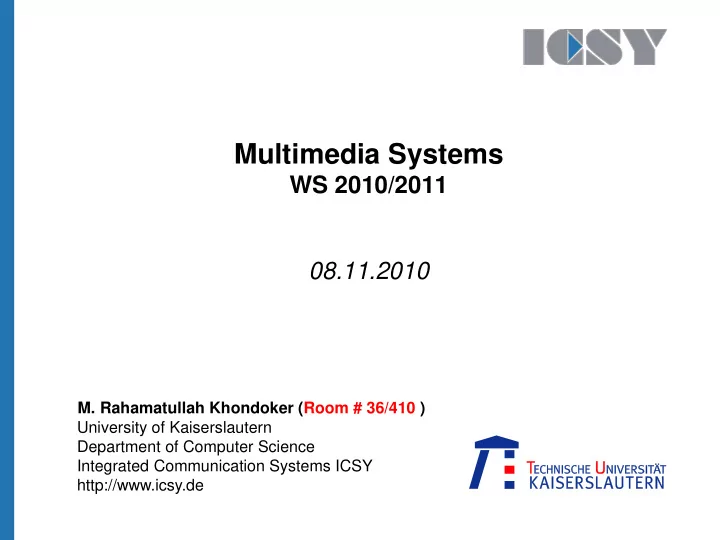

Multimedia Systems WS 2010/2011 08.11.2010 M. Rahamatullah Khondoker (Room # 36/410 ) University of Kaiserslautern Department of Computer Science Integrated Communication Systems ICSY http://www.icsy.de
Outline Data and Signals Signal Basics Digitization Sampling Quantization Encoder Decibels 2 M. Rahamatullah Khondoker, University of Kaiserslautern
Data and Signals Analog data: continuous and takes continuous values Examples: speech, analog clock, hands movement Digital data: have discrete states and takes discrete values Examples: digital clock Analog signal: has infinite number of values in a range Digital signal: have limited number of values 3 M. Rahamatullah Khondoker, University of Kaiserslautern
Signal Basics Signals can be periodic or non-periodic Period (T): time (in second) of one cycle Frequency (f): number of periods in 1 second Frequency (f) and periods (T) are inverse to each other Peak Amplitude (A): absolute value of its highest intensity Fig. Example of periodic signals 4 M. Rahamatullah Khondoker, University of Kaiserslautern
Signal Basics Phase: position of the signal relative to time 0 Fig. Examples of different phases of signal Fig. Examples amplitudes, frequencies and phase 5 M. Rahamatullah Khondoker, University of Kaiserslautern
Digitization
Digitization Digitization is the process of creating digital data from analog signal Steps Sampling Quantizing Encoding Examples encoder Pulse Code Modulation (PCM) Delta Modulation 7 M. Rahamatullah Khondoker, University of Kaiserslautern
Sampling Capture continuous signal in a discrete interval Nyquist – Shannon sampling theorem A signal with a maximum frequency (Nyquist-Frequency, Grenzfrequenz) f max has to be sampled with a minimal frequency of f a =2*f max to allow an accurate reconstruction of the original signal. 8 M. Rahamatullah Khondoker, University of Kaiserslautern
Sampling signal with f s =200 Hz Amplitude Time 1 ------ s 100 9 M. Rahamatullah Khondoker, University of Kaiserslautern
Sampling signal with f s =200 Hz sampling rate of f a =300 Hz Amplitude Time 1 ------ s 100 Maximum frequency of chosen sampling rate is f g = f a /2 = 150 Hz 10 M. Rahamatullah Khondoker, University of Kaiserslautern
Sampling signal with f s =200 Hz sampling rate of f a =300 Hz Amplitude Time 1 ------ s 100 Maximum frequency of chosen sampling rate is f g = f a /2 = 150 Hz Reconstruction results in a the signal with f r = 100 Hz 11 M. Rahamatullah Khondoker, University of Kaiserslautern
Sampling Amplitude Time Frequency (Hz) 1 ------ s 100 f r f g f s Time Domain Frequency Domain 12 M. Rahamatullah Khondoker, University of Kaiserslautern
Sampling Oversampling Theoretically no advantages Usage scenario: Non-optimal filters • Ideal vs. real low-pass filter Disadvantages • no quality gain • more storage space & higher data rates are required Undersampling Signal cannot be reconstructed 13 M. Rahamatullah Khondoker, University of Kaiserslautern
Quantization Transform signal with continuous values into a signal with discrete values 14 M. Rahamatullah Khondoker, University of Kaiserslautern
Quantization Error Occurs when the approximated value is not equal to the real value Low quantization error Low bit rate and low storage consumptions High quality High quantization error High bit rate and high storage consumptions Low quality 15 M. Rahamatullah Khondoker, University of Kaiserslautern
Pulse Code Modulation PCM has PAM Sampler Quantizer Encoder PAM sampler makes PAM pulses Quantizer constitutes PCM pulses Encoder provides digital data 16 M. Rahamatullah Khondoker, University of Kaiserslautern
Decibel
Decibel Signals lost or gained strength is measured by using decibel Relative strength of two signals or one signal at different points A specification in decibel is always related to a reference value! Decibels can be added or subtracted when we are measuring several points instead of two 18 M. Rahamatullah Khondoker, University of Kaiserslautern
Decibel dB(SPL) often simplified: dB sound pressure level • Measurement unit: pascal (Pa) • relative to 20 micropascals ( μ Pa) = 2×10 −5 Pa dB(A), dB(B), dB(C), dB(D) unit adapted to the sound level perception of human hearing A-, B-, or C-Filter for weighting dBm, dBmW electrical power • Measurement unit: milliwatt • Relative to 1 milliwatt dBi Transmission power of antennas • Relative to hypothetical perfect isotropic antenna 19 M. Rahamatullah Khondoker, University of Kaiserslautern
Thanks for your attention Any questions, comments or concerns?
M. Rahamatullah Khondoker, M.Sc. Integrated Communication Systems ICSY University of Kaiserslautern Department of Computer Science P.O. Box 3049 D-67653 Kaiserslautern Phone: +49 (0)631 205-26 43 Fax: +49 (0)631 205-30 56 Email: khondoker@informatik.uni-kl.de Internet: http://www.icsy.de
Recommend
More recommend